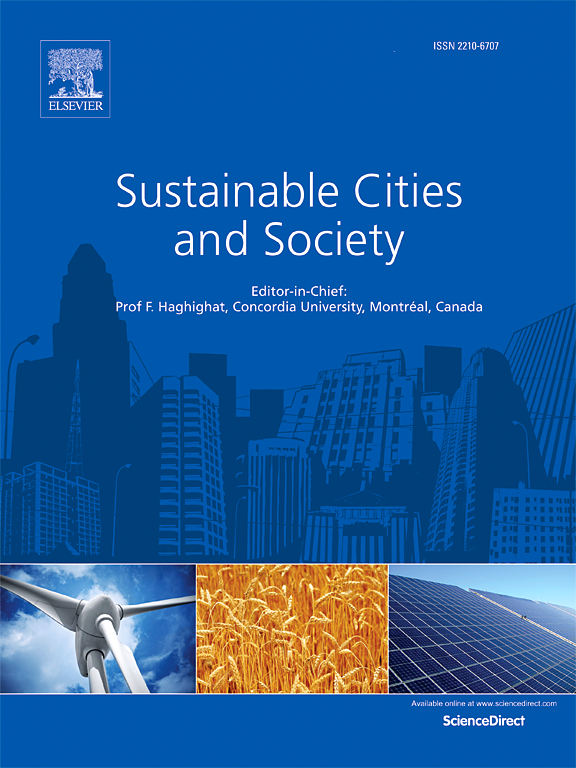The landscape pattern characteristics of urban built-up land significantly influence urban thermal comfort: Evidence from large cities in China
IF 10.5
1区 工程技术
Q1 CONSTRUCTION & BUILDING TECHNOLOGY
引用次数: 0
Abstract
The rapid convergence of urban development drivers and Thermal Comfort (TC) demands highlights a critical gap in understanding the relationship between the Landscape Pattern Characteristics (LPC) of Urban Built-up Land (UBL) and TC. Using Shapley Additive Explanations (SHAP) within an Interpretable Machine Learning (IML) framework, this study investigates the nonlinear, spatially non-stationary impacts of UBL's LPC on TC. The findings reveal complex spatial interactions: (1) A threshold effect between patch area and TC, with TC sharply declining when the Largest Patch Index (LPI) exceeds 0.65 and the Mean Patch Area (AREA_MN) surpasses 0.2; (2) Patch shape complexity exhibits a significant nonlinear relationship with TC: higher Perimeter-Area Fractal Dimension (PAFRAC > 0.36) and Shape Area Metric (SHAPE_AM > 0.22) increase shape irregularity, enhancing heat retention and negatively impacting TC; (3) Moderate patch aggregation, characterized by Patch Density (PD) > 0.15, can improve TC if inter-patch connectivity, measured by Effective Mesh Size (MESH < 0.1), is sufficiently enhanced; (4) The interaction of area, shape, and aggregation characteristics reveals key regulatory mechanisms, highlighting the positive impact of small-scale, simplified morphologies and reduced fragmentation on TC. These findings provide scientific guidance for urban planning and microclimate regulation.
城市建成区景观格局特征显著影响城市热舒适:来自中国大城市的证据
城市发展驱动因素与热舒适需求的快速趋同凸显了在理解城市建设用地景观格局特征与热舒适之间关系方面的关键空白。本研究在可解释机器学习(IML)框架下使用Shapley加性解释(SHAP),研究了UBL的LPC对TC的非线性、空间非平稳影响。结果表明:(1)斑块面积与温度之间存在阈值效应,当最大斑块指数(LPI)超过0.65、平均斑块面积(AREA_MN)超过0.2时,温度急剧下降;(2)斑块形状复杂度与TC呈显著的非线性关系:较高的周长-面积分形维数(PAFRAC >;0.36)和形状面积度量(SHAPE_AM >;0.22)增加形状不规则性,增强保热性,对TC产生负面影响;(3)适度斑块聚集,以斑块密度(patch Density, PD) >为特征;0.15,通过有效网格尺寸(Mesh <;0.1),得到充分增强;(4)面积、形状和聚集特征的相互作用揭示了关键的调控机制,突出了小尺度、简化形态和减少碎片化对TC的积极影响。研究结果为城市规划和微气候调控提供了科学指导。
本文章由计算机程序翻译,如有差异,请以英文原文为准。
求助全文
约1分钟内获得全文
求助全文
来源期刊

Sustainable Cities and Society
Social Sciences-Geography, Planning and Development
CiteScore
22.00
自引率
13.70%
发文量
810
审稿时长
27 days
期刊介绍:
Sustainable Cities and Society (SCS) is an international journal that focuses on fundamental and applied research to promote environmentally sustainable and socially resilient cities. The journal welcomes cross-cutting, multi-disciplinary research in various areas, including:
1. Smart cities and resilient environments;
2. Alternative/clean energy sources, energy distribution, distributed energy generation, and energy demand reduction/management;
3. Monitoring and improving air quality in built environment and cities (e.g., healthy built environment and air quality management);
4. Energy efficient, low/zero carbon, and green buildings/communities;
5. Climate change mitigation and adaptation in urban environments;
6. Green infrastructure and BMPs;
7. Environmental Footprint accounting and management;
8. Urban agriculture and forestry;
9. ICT, smart grid and intelligent infrastructure;
10. Urban design/planning, regulations, legislation, certification, economics, and policy;
11. Social aspects, impacts and resiliency of cities;
12. Behavior monitoring, analysis and change within urban communities;
13. Health monitoring and improvement;
14. Nexus issues related to sustainable cities and societies;
15. Smart city governance;
16. Decision Support Systems for trade-off and uncertainty analysis for improved management of cities and society;
17. Big data, machine learning, and artificial intelligence applications and case studies;
18. Critical infrastructure protection, including security, privacy, forensics, and reliability issues of cyber-physical systems.
19. Water footprint reduction and urban water distribution, harvesting, treatment, reuse and management;
20. Waste reduction and recycling;
21. Wastewater collection, treatment and recycling;
22. Smart, clean and healthy transportation systems and infrastructure;
 求助内容:
求助内容: 应助结果提醒方式:
应助结果提醒方式:


